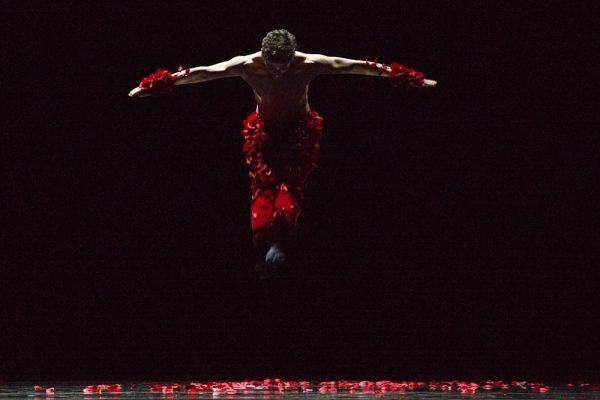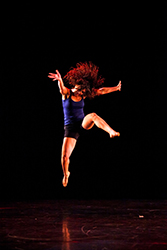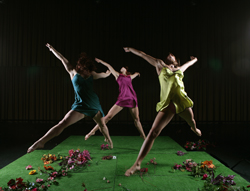There are a lot of ideas floating around in Susan Elliott’s first full-length choreography, “I Seem To Be A Verb”. Not all of them surface, and the choreography is probably many works in one. Almost managing to hold the hour together is an interesting subtext: the act of creation, as experienced by a choreographer still getting used to the job. Examining the artist’s role is a legitimate concern, if a trifle inward-looking.
Elliott, the artistic director of the Vancouver-based company Anatomica, has made numerous shorter, less intense works. For the last three years, she has been artist-in-residence at the Vancouver East Cultural Centre, and is well known, and well loved, as one of the city’s busiest and best dancers. She has intimate knowledge of a myriad of aesthetics, beginning with her years performing the contact improvisation-based work of Peter Bingham through to numerous appearances in the formal, dramatic terms of Lola MacLaughlin’s work.
The title for the present choreography is taken from a book by Buckminster Fuller, the American who invented the geodesic dome in the late 1940s as part of his quest to improve housing for humanity. He is less known as a poet, but his 1970 book, “I Seem To Be a Verb”, contains the poem Elliott quotes in her program notes, including the key lines: “I seem to be a verb/ an evolutionary process/ an integral function of the universe.” Why this would resonate with Elliott is obvious: even more than actors, who are told to “find their verb” in order to enter into their role in an active way, dancers actually embody verbs as they run, leap, fall and turn. Yet it is true that while a choreographer can indeed be imagined as a verb, it is never only as “dancing”; she must also be “thinking,” especially in the world of modern dance. Therein lies much of the angst for which the art form is known, as well as Elliott’s struggle.
This need to think, to make decisions and choices, creates tension in the work, which continually stops short and changes gears. Bright and cheerful one moment, dark and serious the next, Elliott’s choice is to go for it all.
In many ways, as the thinking choreographer, Elliott sets herself apart from her two dancers, Ziyian Kwan and Chengxin Wei. For one thing, her status as choreographer is apparent in the way she sometimes animates Kwan and Wei, gently prodding them into position, or quietly watching them. It’s also clear in the way she verbally directs the game section which opens the work.
“I Seem To Be A Verb” begins with all three performers in bright summer clothes playing games with large cans of tomato juice, stacking them in different formations and running an obstacle course around them. They run and laugh and tease each other in the open stage space. Finally, they stand in a row on a strip of white floor space directly in front of the audience and move through a concentrated series of tense poses.
At this point, the cans are spread out across the front of the stage space, and viewers who are close enough might notice the brand: “Thomas’ Utopia”. This somewhat obscure reference is apparently to Sir Thomas More, the humanist author of the sixteenth-century “Utopia”. I suspect I only paid attention to this because of reading about Elliott’s interest in More’s “Utopia” in a newspaper preview. The cans are a humorous touch but the labels are difficult to read and thus do not make much sense for a stage production.
The next section is dark, and takes place mostly on the centre square of black marley. The trio has changed into beautifully cut black pants and tops by designer Heather Young, and they dance to a dark industrial-disco score by Hannu Huuskonen. Everything looks pretty much like modern dance as we know it today.
But then comes Kwan’s solo, which is created from ordinary movement sources like sneezing, yawning, clapping and running a hand over the buttocks. It’s reminiscent of the main solo for Maria Clara Villa-Lobos in German choreographer Thomas Lehmen’s “mono subjects” from 2001 (seen recently during the Vancouver International Dance Festival), although Lehmen’s intent is more ironic than Elliott’s. Like him, she is exposing the arbitrary nature of choreographic language, defusing its supposedly intellectual inspiration, but doing so gently, so that the solo is surprisingly integrated as dance.
Other solos, including Wei’s, are created from more typical building blocks, juxtaposing a relaxed flow with hard, thrusting changes of direction. In an elegant trio section, the ensemble is tight and the choreography is fast, furious and full of abrupt changes of direction. It does all the things modern dance usually does, with an occasional jazz-style cool.
Production values are high, including the lighting by James Proudfoot that decorates the stage with circles, or blasts forcefully in a white glare. The large, circular drum which hangs in an upstage corner makes a low-tech screen onto which video by Stephanie Butler is projected. The point of the visuals, which include empty train tracks, male and female outlines like those routinely found on washroom doors, people travelling up an elevator, and a geodesic dome, is not clear, but they add a certain busy-ness to the stage that seems appropriate, if slightly distracting. (As an audience member, you have to turn your head and look slightly up to see the projections, and thus miss a few moments of dance.)
Speed, accuracy and tidiness, Elliott tells her dancers at the opening of the piece, are the modest goals of the game they are preparing to play. The piece as a whole is more ambitious. Nonetheless, the heart of the artist — or her mind — is not fully revealed, even by the end.
Tagged: Contemporary, Performance, BC





